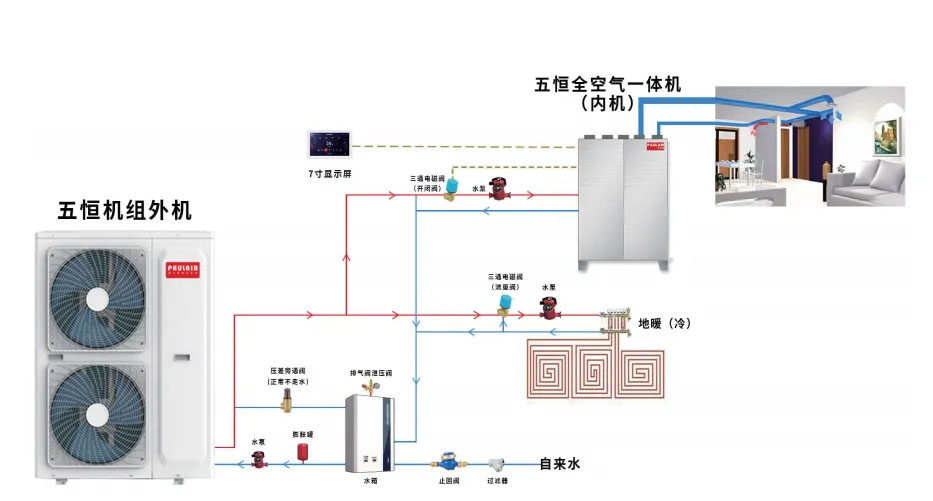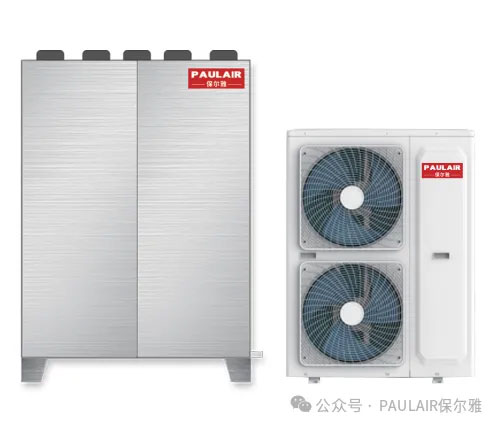The Wuheng all air system is a combination of various equipment that replaces indoor air conditioning, heating, fresh air, dehumidification, humidification, air purification, air sterilization, etc. with a single system, and is based on a health system standard. The computer precisely adjusts the all air control logic. The complete system structure is simple, consisting of a cold and heat source system, an all air system, a ground temperature control system, and an intelligent control system, forming an integrated solution of cold (cooling), warm (heating), air (fresh air), and intelligent (smart) to meet high-end home needs.

During operation, the cold and heat source system extracts heat from the air and transfers it to the water. The ground temperature control system adjusts the indoor temperature by regulating the water temperature, which not only effectively reduces carbon emissions from systems such as air conditioning and HVAC heating, but also improves indoor comfort. Starting from the refrigeration unit, the refrigerant evaporates and absorbs heat in the evaporator, causing the secondary side water to cool down. If the evaporation temperature is too low, it will cause frost on the surface of the evaporator, affecting the heat transfer efficiency. Therefore, the refrigerant evaporation temperature is kept above 0 degrees. There is usually a temperature difference of 3-5 degrees on both sides of the evaporator, with an additional 2 degrees of safety margin, so the outlet temperature should be set at 5-7 degrees. However, considering that increasing the evaporation temperature can improve the efficiency of the main unit, the air conditioning water supply is generally designed at 7 degrees. From the perspective of thermal comfort and health, comprehensive control of indoor temperature and humidity is required. In summer, the human comfort zone is 25 degrees, with a relative humidity of 60%, and the dew point temperature is 16.6 degrees. The task of air conditioning for heat and moisture removal can be seen as extracting heat from a 25 degree environment and moisture from the outside at a dew point temperature of 16.6 degrees. At present, the heat and moisture removal methods of air conditioning are achieved by cooling and condensing the air through an air cooler, and then sending the cooled and dried air indoors to achieve the purpose of heat and moisture removal. If the air conditioning supply only needs to meet the requirements of indoor heat dissipation, the temperature of the cold source should be lower than the dry bulb temperature of the indoor air (25 degrees). Considering the temperature difference between heat transfer and medium transportation, the temperature of the cold source only needs to be 15 to 18 degrees. If the air conditioning supply needs to meet the requirements of indoor dehumidification, due to the use of condensation dehumidification method, the temperature of the cold source needs to be 16.6 degrees lower than the indoor air dew point temperature. Considering the 5-degree heat transfer temperature difference and 5-degree medium delivery temperature difference, achieving a dew point temperature of 16.6 degrees requires a cold source temperature of 6.6 degrees. This is the reason why existing air conditioning systems use 5-7 degrees chilled water. Or in other words, for conventional air conditioning systems, the key to humidity control is to ensure a sufficiently low chilled water supply temperature. If the summer design temperature and humidity are analyzed according to DB24 ℃/RH50%, the corresponding dew point temperature is 12.9 ℃. That is to say, when using the conventional self intake fresh air and one-time return air treatment scheme, the air needs to be cooled to around 12.5 ℃ (dew point of the machine) to ensure the relative humidity requirements indoors; If the fresh air centralized treatment or fresh air pretreatment scheme is adopted, the air needs to be cooled to at least 12 ℃ or below. To achieve such a treatment effect, 7 ℃ is the minimum standard for the supply temperature of chilled water. That is to say, throughout the entire cooling season, it is necessary to ensure that the supply temperature of the air conditioning chilled water does not exceed 7 ℃.

Analysis of the reasons for 12 ° return water
The return water temperature is set to 12 degrees, tsssssssaking into account the characteristics of fan coil units and other end devices. When the supply water temperature is 7 degrees and the return water temperature is set to 12 degrees, that is, when the temperature difference between the supply and return water is 5 degrees, the energy consumption of the water pump and the system and the heat exchange efficiency of the end equipment reach the optimal economic balance point. When ensuring a water supply temperature of 7 degrees, increasing the return water temperature is equivalent to increasing the temperature difference between the supply and return water. Therefore, for a specific fan coil unit, under the same heat exchange rate, the water flow rate should be reduced; And a decrease in flow rate, that is, a decrease in water flow velocity, will lead to a decrease in the heat transfer coefficient of the coil. Therefore, for fan coil units, in order to ensure that the heat transfer remains unchanged, it is necessary to increase the area of the surface cooler. Assuming the air volume of the fan coil remains constant and the average water temperature is the same but the water temperature difference is different, for example, when the inlet and outlet temperatures of the chilled water change from 7 ℃/12 ℃ to 6 ℃/13 ℃, the cooling capacity of the fan coil decreases by 12%. If the return water temperature is reduced, it is equivalent to reducing the temperature difference. Therefore, while keeping the heat exchange constant, the water flow rate needs to be increased, which will increase the energy consumption of the water pump and the initial investment of the system. As the temperature difference between the supply and return water increases, while the cooling capacity of the fan coil decreases, the dehumidification ability of the fan coil also significantly decreases, which can easily lead to unsatisfactory dehumidification requirements for air-conditioned rooms. On the other hand, appropriately reducing the supply temperature of chilled water can partially offset the adverse effects caused by the increased temperature difference in chilled water supply. Therefore, in order for the large temperature difference design to truly achieve energy-saving goals during operation, certain measures must be taken for fan coil units to compensate for the impact of large temperature differences. Such as reducing the temperature of the chilled water, increasing the number of coil rows, and installing baffles inside the coils to enhance heat transfer, etc.
